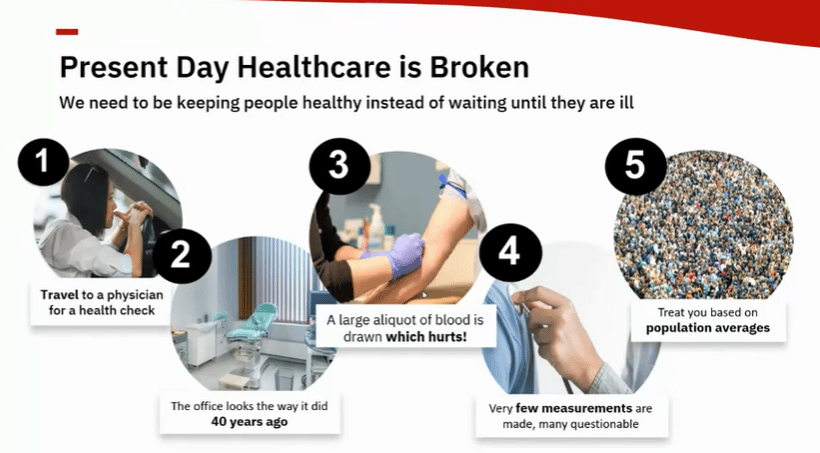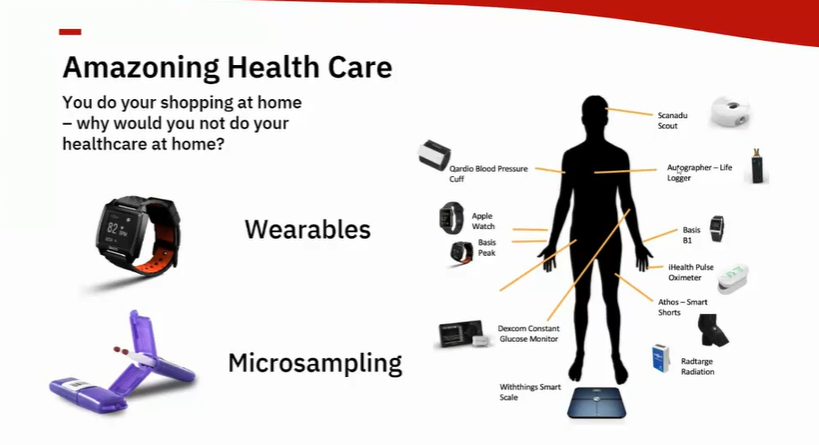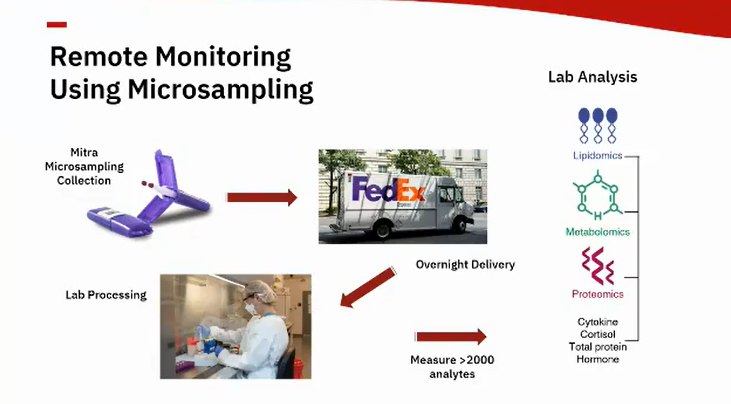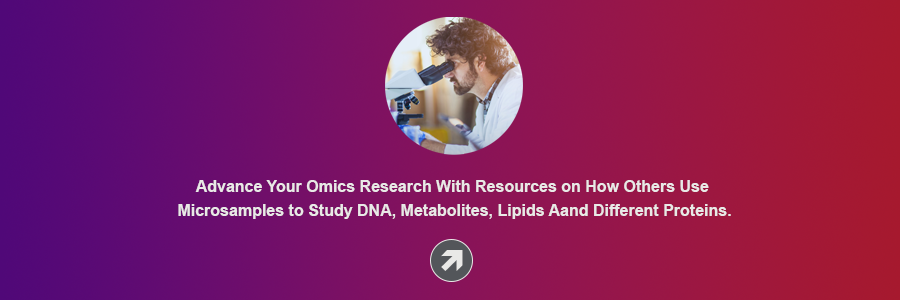Share this
Big Data, Remote Monitoring for Transforming Healthcare
by Neoteryx Microsampling on July 17,2023
July 2023 — A recent webinar on using big data, remote monitoring and remote microsampling for omics studies to transform healthcare was hosted by The Evidence Base®, an online hub that provides the latest news on real-world data, health economics and outcomes research.
Webinar moderator Neil Spooner, PhD, Director, Spooner Bioanalytical Solutions and Co-Founder of the Patient Centric Sampling Interest Group (PCSIG) was joined by leading genomicist Michael Snyder, PhD, Professor & Chair, Stanford University School of Medicine. Dr. Snyder's topic was the use of big data and remote monitoring to transform healthcare today.
At the top of his webinar presentation, Dr. Snyder highlighted how our present healthcare system focuses on treating people when they are ill rather than on how to prevent them from becoming ill.
 Infographic courtesy of Michael Snyder, PhD, Snyder Lab, Stanford Medicine
Infographic courtesy of Michael Snyder, PhD, Snyder Lab, Stanford Medicine
Dr. Snyder explained that he and his colleagues in the Snyder Lab at Stanford Medicine believe that each of the steps followed in the current healthcare system can be improved. They have been using big data and remote monitoring devices to monitor people while they are healthy with the aim of learning how to keep them that way and to detect disease before symptoms appear.
Remote Monitoring Enables Multi-Omics Studies in the Snyder Lab at Stanford Medicine
"We believe that that advanced technologies have the potential to transform healthcare and keep people healthy," said Dr. Snyder.
Dr. Snyder et al use advanced multi-omics technologies (genomics, immunomics, transcriptomics, proteomics, metabolomics, microbiomics) as well as wearables and remote blood microsampling devices to actively monitor health. They have used these technologies for early detection of infectious disease, including COVID-19, as well as for monitoring health under different conditions that may help improve lifestyle choices.
Monitoring Big Data Can Help Healthcare Systems Better Manage Health
In a long-term multi-omics study, the Snyder Lab researchers have followed a group of 109 individuals for roughly 13 years to gain health insights on cardiovascular disease, oncology, metabolic health and infectious disease. They have studied blood samples and plasma taken from the study participants to understand all aspects of their health.
Such studies have led to interesting discoveries about human health and how it changes over time and from person to person. For example, they found that individuals have distinct aging patterns that can be measured in an actionable period of time. Some people are "immune agers" who can take measures to boost immunity, while others are "kidney agers" who can make lifestyle choices that protect their kidney health.
The researchers also have learned that it's important for each individual to know their healthy baseline data (i.e., their baseline body temperature), for example, so they know that "something is off" when their health measures change.
How Wearables and Remote Microsampling Can Provide Benefits
Dr. Snyder and colleagues believe it will soon be possible to "Amazonize" healthcare by taking a remote, home-based approach to monitoring health. People can do this in two ways: 1) By wearing health devices that monitor them 24/7, and 2) by using remote microsampling devices to collect micro-sized blood samples and other specimen samples at home.

Infographic courtesy of Michael Snyder, PhD, Snyder Lab, Stanford Medicine
Dr. Snyder listed numerous technologies that can be used for remote monitoring. The purple product pictured above in Dr. Snyder's slide is a Mitra® device based on VAMS® microsampling technology from Trajan Scientific and Medical. These microsampling devices can help simplify the steps taken to getting a health check-up.
Amazonizing of Healthcare: Dr. Snyder proposed that providers can mail blood sample collection kits to people at home. Individuals can use the enclosed microsampling device and supplies to self-collect 2-4 blood samples from a quick fingerstick. Then they mail the samples back to the lab for testing.
The blood microsamples can be shipped to the lab via standard mail or overnight delivery. No special cold-shipping is necessary because Mitra microsamples don't need to be refrigerated. They will dry on the device in transit and are analyzed in the lab following a dried blood spot (DBS) workflow for sample processing.

Infographic courtesy of Michael Snyder, PhD, Snyder Lab, Stanford Medicine
This content was curated from the webinar hosted by The Evidence Base and the Patient Centric Sampling Interest Group (PCSIG).
To learn more about the adoption of blood Microsampling in Omics Research visit our resource page.
Image Credits: Dr. Michael Snyder, Snyder Lab, Stanford Medicine; FedEx; Apple; Scanadu; iHealth Labs Inc; Athos Apparel; Basis; RadTarge; Autographer (OMG Life); Withings; Qardio; Dexcom
Share this
- Microsampling (41)
- Industry News, Microsampling News (35)
- Mitra® Device (34)
- Company Press Release, Product Press Release (22)
- Research, Remote Research (18)
- Infectious Disease, Vaccines, COVID-19 (15)
- Clinical Trials, Clinical Research (14)
- Biomonitoring, Health, Wellness (10)
- Blood Microsampling, Serology (10)
- Decentralized Clinical Trial (DCT) (8)
- Omics, Multi-Omics (7)
- Venipuncture Alternative (6)
- Skin Microsampling, Microbiopsy (5)
- Harpera Device (3)
- Specimen Collection (3)
- Toxicology, Doping, Drug/Alcohol Monitoring, PEth (3)
- Pharmaceuticals, Drug Development (2)
- Therapeutic Drug Monitoring, TDM (2)
- Antibodies, MAbs (1)
- Environmental Toxins, Exposures (1)
- Preclinical Research, Animal Studies (1)
- hemaPEN® Device (1)
- December 2025 (1)
- May 2025 (1)
- April 2025 (1)
- February 2025 (4)
- September 2024 (1)
- August 2024 (1)
- May 2024 (2)
- January 2024 (1)
- December 2023 (2)
- November 2023 (3)
- October 2023 (2)
- September 2023 (1)
- August 2023 (3)
- July 2023 (3)
- June 2023 (1)
- May 2023 (2)
- April 2023 (1)
- March 2023 (2)
- February 2023 (1)
- January 2023 (2)
- December 2022 (1)
- November 2022 (1)
- October 2022 (2)
- August 2022 (1)
- April 2022 (1)
- February 2022 (1)
- January 2022 (1)
- December 2021 (1)
- November 2021 (1)
- October 2021 (2)
- September 2021 (1)
- August 2021 (2)
- July 2021 (2)
- June 2021 (2)
- April 2021 (1)
- March 2021 (2)
- February 2021 (1)
- January 2021 (1)
- December 2020 (1)
- November 2020 (1)
- October 2020 (1)
- September 2020 (2)
- August 2020 (3)
- July 2020 (3)
- June 2020 (2)
- May 2020 (1)
- April 2020 (3)
- October 2019 (1)
- March 2019 (1)
- January 2019 (1)
- November 2018 (1)
- August 2018 (1)
- July 2018 (1)
- June 2017 (1)
- April 2017 (1)
- March 2017 (1)
- February 2017 (1)
- May 2016 (1)
- December 2015 (1)
- October 2015 (1)
- August 2015 (1)
- August 2014 (1)
- July 2014 (1)



No Comments Yet
Let us know what you think